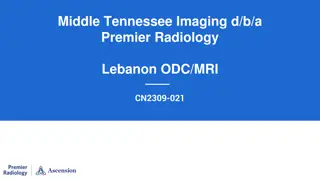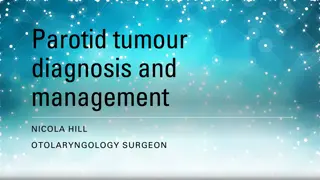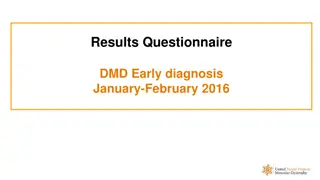Intracranial Gliomas: Radiology, Diagnosis, and Management Overview
This comprehensive overview covers the classification, subtypes, and spatial definitions of intracranial gliomas, including astrocytic tumors, oligodendrogliomas, ependymal tumors, neuronal tumors, pineal tumors, and embryonal tumors. It also discusses low-grade gliomas and spatial definitions based on tumor characteristics.
Download Presentation

Please find below an Image/Link to download the presentation.
The content on the website is provided AS IS for your information and personal use only. It may not be sold, licensed, or shared on other websites without obtaining consent from the author. Download presentation by click this link. If you encounter any issues during the download, it is possible that the publisher has removed the file from their server.
E N D
Presentation Transcript
INTRACRANIAL GLIOMAS- RADIOLOGY, DIAGNOSIS AND MANAGEMENT
Introduction WHO classification (2000) of CNS tumors: Neuroepithelial tissue Cranial an spinal nerves Meninges Hematopoietic system Germ cell Cysts and tumor like condition Tumors of the sellar region Local extension of regional tumors Metastatic tumors 1. 2. 3. 4. 5. 6. 7. 8. 9.
Neuroepithelial tumors Sub classification: Astrocytic tumors: A. Diffusely infiltrating: 1. Astrocytoma- fibrillary 1. protoplasmic gemistocytic mixed 2. Anaplastic astrocytoma 3. Glioblastoma multiforme: Grade 1V Giant cell Gliosarcoma B. Circumscribed lesions: 1. Pilocytic astrocytoma 2. Plemorphic Xanthoastrocytoma 3. Subependymal Giant cell astrocytoma
2. Oligodendrogliomas 3. Ependymal tumors: ependymomas anaplastic myxopapillary subependymomas 4. Mixed gliomas 5. Choroid plexus tumors: papilloma carcinoma Tumors of uncertain origin: astroblastoma polar spongioblastoma gliomatosis cerebri
7. Neurons: a. ganglioglioma b. dysplastic gangliocytoma c. desmoplastic infantile ganglioglioma d. dysplastic neuroepithelial tumors e. gangliocytoma f. central neurocytomas g. olfactory neuroblastomas
8. Pineal tumors: pinealocytomas pinealoblastomas mixed pineal tumors 9. Embryonal tumors: medulloepithelioma neuroblastoma retinoblastoma primitive neuroectodemal tumors( PNET): a. medulloblastoma 1. desmoplastic 2. medullocytoma 3. melanotic b. cerebral and spinal PNET s
Low Grade Gliomas Classified as: 1. WHO grade II astrocytomas 2. Oligodendrogliomas 3. Mixed oligodendrocytic/ astrocytic 4. Gangliogliomas 5. Juvenile pilocytic astrocytomas 6. Pleomorphic astrocytomas 7. Dysembryoplastic neuroepithelial tumors
Spatial definition Type I: Solid tumor without infiltration: pilocytic astrocytoma, ganglioglioma Type II: Solid tumors with infitration: grade II astrocytoma Type III: Infilterative without solid component: oligodendroglioma
Grading of gliomas WHO Based on cellularity,pleomorphism,vascular, proliferation, necrosis I Special tumors II Astrocytomas (low grade) III Anaplastic Astrocytomas IV Glioblastoma Kernohan St Anne/Mayo :atypia,mitosis,endothelial proliferation,necrosis
Grading by CT/MRI I : CT; Low density, MRI; Abnormal signal no mass effect, no enhancement II : CT; low density, MRI;abnormal signal mass effect, no enhancement III : Complex enhancements IV :Necrosis ( ring enhancement)
Pathological features Diffuse astrocytomas: Gross findings: Adults hemispheric, children brainstem. Alter color, texture of tissue. Microscopy: Hyper chromatic nuclei GFAP containing cell process Astrocytic cells without macrophages/ microglia Cells distributed in clumps( fibrillary/ protoplasmic, gemistocytic)
Anaplastic astrocytomas Margins better defined Cells populous/pleomorphic Perineural satellitoses Absence of necrosis/ vascular proliferation
Glioblastomas Occur denovo Dedifferentiation Macroscopic picture: grey fleshiness/ cystic / necrotic areas wide spread Microscopic picture: Astrocytes with long fine process with vascular proliferation/ necrosis large cells bizarre- giant cell GBM gliosarcoma Adequate pathological specimen required
Pilocytic astrocytoma Macroscopic picture: Optic nerve- fusiform dilatation Hypothalamic- soft lobular Cerebellar- well circumscribed Cerebral Microscopic picture: Elongated cells/ rosenthal fibres
Pleomorphic xanthoastrocytomas Young adults Superficial cortical areas Temporal lobe Cellular pleomorphism Lipidisation of cells Low mitotic rate Necrosis absent
Subependymal giant cell astrocytoma Tuberous sclerosis Abundant eosinophilic cytoplasm Neurofilament protein
Oligodendroglioma Cerebral hemispheres: frontal lobe Both grey and white matter Monotonous round cells Perineural satellitoses Calcification Perinuclear haloes GFAP negative High/ low grade
Ependymoma Frontal horns to filum IV ventricle/ filum Discrete Perivascular pseudo rosette Myxopapillary variant- caudal cell mass Gangliogliomas: both neural and glial cells
Clinical features Due to raised ICP: headache nausea/ vomiting nuchal rigidity papilloedema VI nerve palsy Site specific changes: Irritative- seizures destructive- mental apathy memory loss personality disturbance focal neurological findings Progressive nature
Diagnosis Imaging- pre operative postoperative intra operative CT MRI SPECT Angiography
Imaging appearance Homogenous changes: reduced attenuation on CT hypo on T1W hyper on T2W Mixed/ inhomogenous changes Mildly/ homogenously increased density on CT/ T1W Hypo/ iso on T2W
Grading features Homogenity Margins Cysts/ necrosis Calcification Edema
Low Grade Astrocytomas CT: low density homogenous mass that is poorly marginated MRI: hypo on T1W/ hyper on T2W mass effect is less non enhancement D/D: cerebral infarct area of demyelination
Anaplastic astrocytomas Mass effect is greater Moderate contrast enhancement Absence of areas of necrosis and hemorrhage D/D solitary metastasis/ acute demylination
Glioblastoma multiforme Irregular homogenous areas of abnormality that are poorly marginated Hyper density on CT Hyper on T1W/ hypo on T2W Contrast enhancement Non enhancing areas Areas of hemorrhage D/D: Metastases/ abscess/ malignant meningioma
Oligodendroglioma Centrum semiovale of cerebral hemispheres/ found in adults CT. X-Rays prominent calcification MRI similar to astrocytoma D/D: central neurocytoma/ intraventricular meningiomas
Ependymoma Location Mimic low/ intermediate grade gliomas Homgenous Moderate enhancement Gangliogliomas: temporal lobe/ posterior fossa calcification/ cysts
Other modalities Angiography: tumor/ giant aneurysm superficial/ intra axial/ extra axial masses vascularity FDG/ PET: grading/ treatment response/ recurrence/ radionecrosis MRS: lactate/ choline/ NAA/ creatine
Diffusion perfusion weighted images SPECT, thallium201/ technetium99/ iodine 123 Functional imaging- MRI/ PET/ MEG
PreoperativeTreatment Anticonvulsants Peritumoral edema: steroids/head end elevation/ mannitol/ diuretics/ hyper ventilation
Definitive treatment Surgery Radiotherapy Chemotherapy Others
Surgery Timing: early/ late Type of surgery: experience of surgeon attempt at gross total removal image guided surgery
Indication: establishing diagnosis pilocytic astrocytoma mass effect hydrocephalus seizures to delay adjuvant therapy small tumors
Role of surgery limited in: disseminated tumors multifocal tumors location in eloquent areas
Radiotherapy Controversial area No conclusive benefit Risk of radiation induced complications
Recommendations: - in cases of gross total removal/ incomplete removal in pilocytic astrocytomas RT to be withheld - incomplete removal of low grade glioma- 45 GY to tumor bed and 2 cm margin - malignant degeneration to be treated RT - Chiasmal/ hypothalamic tumors
Chemotherapy Not indicated except in tumor progression PCV regimen Pilocytic astrocytoma: cerebellum/ optic nerve/ hypothalamic glioma























